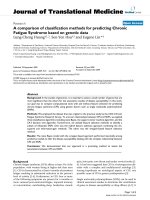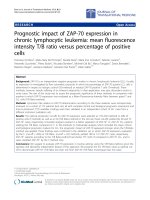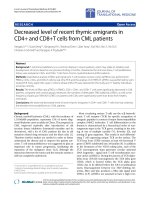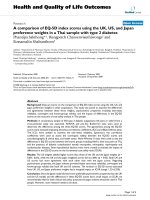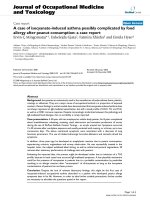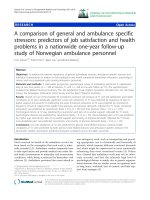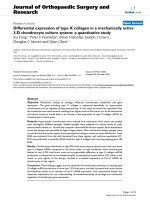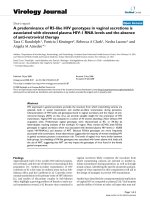Báo cáo hóa học: " A predominance of R5-like HIV genotypes in vaginal secretions is associated with elevated plasma HIV-1 RNA levels and the absence of anti-retroviral therapy" docx
Bạn đang xem bản rút gọn của tài liệu. Xem và tải ngay bản đầy đủ của tài liệu tại đây (206.78 KB, 4 trang )
BioMed Central
Page 1 of 4
(page number not for citation purposes)
Virology Journal
Open Access
Short report
A predominance of R5-like HIV genotypes in vaginal secretions is
associated with elevated plasma HIV-1 RNA levels and the absence
of anti-retroviral therapy
TaraCRandolph
1
, Patricia J Kissinger
2
, Rebecca A Clark
1
, Nedra Lacour
1
and
Angela M Amedee*
1
Address:
1
Department of Microbiology, Immunology, and Parasitology, Louisiana State University Health Sciences Center, New Orleans, LA, USA
and
2
School of Public Health and Tropical Medicine, Tulane University Health Sciences Center, New Orleans, LA, USA
Email: Tara C Randolph - ; Patricia J Kissinger - ; Rebecca A Clark - ;
Nedra Lacour - ; Angela M Amedee* -
* Corresponding author
Abstract
HIV expressed in genital secretions provides the inoculum from which transmitting variants are
selected, both in sexual transmission and mother-to-infant transmission during partuition.
Characterization of HIV levels and genotypes found in vaginal secretions and the impact of anti-
retroviral therapy (ART) on this virus can provide valuable insight for the prevention of HIV
transmission. Vaginal HIV was evaluated in a cohort of 43 women attending a New Orleans HIV
outpatient clinic. Predominant vaginal genotypes were characterized as R5- or X4-like by
heteroduplex tracking analyses of the envelope V3 region. Most women (67.4%) shed R5-like
genotypes in vaginal secretions which was associated with elevated plasma HIV levels (≥ 10,000
copies HIV-RNA/mL) and absence of ART. Because R5-like genotypes are more frequently
associated with transmission, these observations suggest that the majority of women shedding HIV
in genital secretions present a transmission risk. The levels of vaginal virus were similar between
both groups, but shedding of X4-like genotypes was associated with lower plasma viral loads and
the use of ART, suggesting that ART use may impact the genotypes of virus found in the female
genital compartment.
Findings
Approximately half of the world's HIV-infected popula-
tion is female, and the rate of infection is increasing in this
population [1]. Mother-to-infant transmission of HIV
continues to be a dire issue in endemic areas such as Sub-
Saharan Africa and the Caribbean [1,2]. Currently, heter-
osexual transmission is the primary route of HIV infection
[1], and studies of discordant couples in Sub-Saharan
Africa highlight a growing problem of female to male sex-
ual transmission events [3,4]. Because virus contained in
vaginal secretions likely comprises the inoculum from
which transmitting variants are selected in mother-to-
infant transmission during partuition, as well as through
sexual contact, identifying the specific properties and gen-
otypes of virus expressed in this compartment will aid in
the design of strategies to prevent HIV transmission.
Studies have described the compartmentalized replication
of vaginal HIV as compared to plasma [5,6]. Viral tropism
and the ability of virions to infect cell types that may traf-
Published: 29 July 2008
Virology Journal 2008, 5:87 doi:10.1186/1743-422X-5-87
Received: 2 May 2008
Accepted: 29 July 2008
This article is available from: />© 2008 Randolph et al; licensee BioMed Central Ltd.
This is an Open Access article distributed under the terms of the Creative Commons Attribution License ( />),
which permits unrestricted use, distribution, and reproduction in any medium, provided the original work is properly cited.
Virology Journal 2008, 5:87 />Page 2 of 4
(page number not for citation purposes)
fic to specific tissues, such as the vaginal mucosa, are influ-
enced by the virus' envelope sequence, which determines
the molecules utilized for entry [7]. The nucleotide
sequence of the HIV envelope V3 region determines
whether the virion utilizes a CCR5 (R5) or CXCR4 (X4)
coreceptor molecule, therefore the V3 genotype can
impact compartmentalized replication of virus in the gen-
ital mucosa [5,7,8].
To evaluate the properties of HIV expressed in the genital
tract and the potential impact of ART on genital tract viral
genotypes, we measured HIV-1 RNA levels in vaginal
secretions and plasma, determined the V3 genotype of
predominant variants found in vaginal secretions, and
assessed ART use in a cohort of 43 women attending an
HIV outpatient clinic in New Orleans. Informed consent
was obtained in accordance with Louisiana State Univer-
sity Health Sciences Center and Tulane Medical Center
IRB approval. ART use was evaluated by the subject's
answer to the question "Are you currently taking ART?" on
a survey questionnaire completed at the study visit. ART
use was also confirmed by review of medical chart data.
Vaginal secretions were collected from the vaginal vault
on Dacron swabs and subsequently eluted in phosphate-
buffered solution. Supernatant and cell fractions were
stored at -80°C within three hours of collection. Samples
were not collected during menses, and overtly blood-con-
taminated samples were excluded. Blood samples were
collected in ethylenediaminetetraacetic acid (EDTA) anti-
coagulant tubes, and plasma aliquots were stored frozen
at -80°C. HIV contained in plasma and vaginal secretion
supernatant samples was collected by centrifugation and
virion-associated HIV-1 RNA copies were quantified using
the Roche Amplicor™ Ultra-Sensitive HIV-1 Monitor
Assay, according to assay protocol.
Samples from a cohort of 43 women with measurable lev-
els (>50 copies/sample) of vaginal HIV-1 RNA were avail-
able for genotypic analysis in this study. To evaluate viral
genotypes shed in vaginal secretions, the envelope V3
region was amplified by nested RT-PCR from the remain-
ing isolated RNA and analyzed by a heteroduplex tracking
assay (HTA) based on an established protocol [9]. This
methodology provides a facile means to evaluate nucle-
otide changes between a reference sequence and
sequences amplified from each vaginal sample. This pro-
tocol has been utilized and validated for analyses of HIV
genotypes and prediction of coreceptor usage [9-13]. The
genotypic evaluations by heteroduplex analysis in this
study were conducted using sample-derived HIV-V3 PCR
products, pooled from 2–4 independent PCR amplica-
tions. The 334 base pair V3 PCR products were mixed with
a single-stranded
32
P-radiolabeled probe containing the
V3 sequence of an X4-utilizing strain, HIV
HXB
. Following
electrophoresis on a non-denaturing acrylamide gel,
mobility ratios of the heteroduplexes formed between
sample and probe V3 sequences were analyzed and used
to determine the predominant genotype of the patient
sample, as described [9,12,13]. R5-like genotypes had a
reduced mobility on the gel when heteroduplexed with
the X4-like sequence probe (mobility ratio < 0.91), while
heteroduplexes formed between patient X4-like sequences
and the X4 probe had higher mobility ratios (>0.91).
A wide range of viral levels in both the plasma and vaginal
compartments was observed in this cohort, 50 to 5 × 10
5
copies/mL plasma and 50 to 2 × 10
5
copies/vaginal sam-
ple. For statistical analysis, HIV RNA levels in both plasma
and vaginal secretions were categorically designated as
high-level HIV or low-level HIV for each, as defined in
Table 1. The majority of women, 67.4%, had R5-like gen-
otypes in vaginal secretions, while 32.6% shed X4-like
genotypes. To identify viral and clinical factors associated
with vaginal X4- or R5-like genotypes, we evaluated
plasma and vaginal viral levels, ART use, and CD4+ T lym-
phoctye counts using Chi-square and Fisher's exact tests
(Table 1). R5-like vaginal HIV genotypes were associated
with high levels of plasma virus and the absence of ART.
Table 1: Vaginal Genotypic Associations in 43 Women
R5-like Genotypes
(n = 29)
X4-like Genotypes
(n = 14)
p-value*
High Plasma RNA Levels
≥ 10,000 copies HIV RNA/mL
62.1% 14.3% 0.01
Low Plasma RNA Levels
< 1,000 copies HIV RNA/mL
20.7% 71.4% 0.004
High Vaginal RNA Levels
> 500 copies HIV RNA/sample
48.3% 44.4% 1.00
Low Vaginal RNA Levels
< 100 copies HIV RNA/sample
41.4% 42.9% 0.81
ART Use 38.0% 85.7% 0.01
< 200 CD4+ T lymphocytes/ul 34.6% 44% 0.44
#
*Chi Square (
Χ
2
) analyses
#Fisher Exact Test; data from 81% of the cohort available for analysis
Virology Journal 2008, 5:87 />Page 3 of 4
(page number not for citation purposes)
Conversely, X4-like genotypes in vaginal fluids correlated
with lower plasma levels and use of ART. Levels of HIV in
vaginal secretions were similar between both groups.
The presence of predominantly R5-like genotypes in the
vaginal compartment has significant implications for HIV
transmission. Genotypes that utilize the CCR5 coreceptor
are most commonly transmitted in both sexual and
mother-to-infant transmission [14]. This collective data
suggests the majority of women shedding vaginal HIV
present a high transmission risk. Furthermore, vaginal R5-
like genotypes were associated with absence of ART use.
Reasons for ART use/non-use were not documented for
this cohort and are often multifactorial, especially in
women. Subjects taking ART (n = 23) and those not taking
ART (n = 20) had similar levels of peripheral CD4+ T lym-
phocytes, indicating that advanced disease was not the
main factor driving ART use in this cohort. Additionally,
subjects shedding R5-like genotypes as compared to
women with X4-like vaginal genotypes had similar levels
of peripheral CD4+ T lymphocytes (Table 1). Plasma lev-
els of HIV were lower in ART users as compared to non-
users, however ART users represented more than half of
the women in this shedding cohort, demonstrating that
vaginal HIV shedding occurs in a number of women tak-
ing ART. ART use was associated with the presence of pre-
dominantly X4-like variants in vaginal secretions, which
are less likely to be transmitted [14]. These observations
suggest that ART effectively controls the expression of R5-
like genotypes in the vaginal compartment.
Due to sample availability, HTA analyses were not con-
ducted on matched plasma samples. Although it is possi-
ble to harbor dual-tropic viral variants [9,13], the low
levels of HIV detected in many of the samples only
allowed the analysis of the predominant genotypes in
genital secretions. Despite this, and the inherent limita-
tions of PCR amplification methodologies, these prelimi-
nary findings demonstrate ART's impact on genital HIV
genotypes. These data provide a basis for future evalua-
tions of HIV treatment in women to fully examine com-
partmentalized vaginal expression and the effectiveness of
ART on X4-like and R5-like genotypes in vaginal secre-
tions as a means to reduce transmission risk.
List of Abbreviations
HIV: Human immunodeficiency virus; ART: Antiretroviral
therapy; CCR5: Chemokine (C-C motif) receptor 5;
CXCR4: Chemokine (C-X-C motif) receptor 4; RNA: Ribo-
nucleic acid; PCR: Polymerase chain reaction; IRB: Institu-
tional review board.
Competing interests
The authors declare that they have no competing interests.
Authors' contributions
TR conducted HTA analyses, participated in PCR sample
preparation, carried out data analysis, and drafted the
manuscript. PK participated in the study design and con-
ducted the statistical analyses. RC participated in the
design and coordination of the study and facilitated the
collection of clinical samples. NL processed clinical sam-
ples and conducted PCR and viral load analyses. AA par-
ticipated in the coordination of the study, directed sample
and data analysis, and assisted in drafting the manuscript.
Acknowledgements
We wish to thank Nurse Practitioners Jeanne Dumestre and Louann
Wenthold for their assistance with this study. We would also like to
acknowledge and thank the staff and patients of the New Orleans HIV Out-
patient Program. This study was supported by grants from the Louisiana
Board of Regents Health Excellence Fund, the Centers for Disease Control
and Prevention RA1/CCR622272, and the Gulf South STI/Topical Microbi-
cide Cooperative Research Center NIAID 1U19 AI61972-01.
References
1. UNAIDS: 2007 AIDS Epidemic Update Global Summary of
the HIV and AIDS Epidemic. 2007.
2. Quinn TC, Overbaugh J: HIV/AIDS in women: an expanding epi-
demic. Science 2005, 308(5728):1582-1583.
3. Fideli US, Allen SA, Musonda R, Trask S, Hahn BH, Weiss H, Mulenga
J, Kasolo F, Vermund SH, Aldrovandi GM: Virologic and immuno-
logic determinants of heterosexual transmission of human
immunodeficiency virus type 1 in Africa. AIDS Res Hum Retrovi-
ruses 2001, 17(10):901-910.
4. Quinn TC, Wawer MJ, Sewankambo N, Serwadda D, Li C, Wabwire-
Mangen F, Meehan MO, Lutalo T, Gray RH: Viral load and hetero-
sexual transmission of human immunodeficiency virus type
1. Rakai Project Study Group. N Engl J Med 2000,
342(13):921-929.
5. Kemal KS, Foley B, Burger H, Anastos K, Minkoff H, Kitchen C, Phil-
pott SM, Gao W, Robison E, Holman S, Dehner C, Beck S, Meyer WA
3rd, Landay A, Kovacs A, Bremer J, Weiser B: HIV-1 in genital
tract and plasma of women: compartmentalization of viral
sequences, coreceptor usage, and glycosylation. Proc Natl Acad
Sci U S A 2003, 100(22):12972-12977.
6. Sullivan ST, Mandava U, Evans-Strickfaden T, Lennox JL, Ellerbrock
TV, Hart CE: Diversity, divergence, and evolution of cell-free
human immunodeficiency virus type 1 in vaginal secretions
and blood of chronically infected women: associations with
immune status. J Virol 2005, 79(15):9799-9809.
7. Berger EA, Murphy PM, Farber JM: Chemokine receptors as HIV-
1 coreceptors: roles in viral entry, tropism, and disease. Annu
Rev Immunol 1999, 17:657-700.
8. Xiao L, Owen SM, Goldman I, Lal AA, deJong JJ, Goudsmit J, Lal RB:
CCR5 coreceptor usage of non-syncytium-inducing primary
HIV-1 is independent of phylogenetically distinct global HIV-
1 isolates: delineation of consensus motif in the V3 domain
that predicts CCR-5 usage. Virology 1998, 240(1):83-92.
9. Nelson JA, Fiscus SA, Swanstrom R: Evolutionary variants of the
human immunodeficiency virus type 1 V3 region character-
ized by using a heteroduplex tracking assay. J Virol 1997,
71(11):8750-8758.
10. Delwart EL, Gordon CJ: Tracking changes in HIV-1 envelope
quasispecies using DNA heteroduplex analysis. Methods 1997,
12(4):348-354.
11. Freel SA, Fiscus SA, Pilcher CD, Menezes P, Giner J, Patrick E, Lennox
JL, Hicks CB, Eron JJ Jr., Shugars DC:
Envelope diversity, corecep-
tor usage and syncytium-inducing phenotype of HIV-1 vari-
ants in saliva and blood during primary infection. Aids 2003,
17(14):2025-2033.
12. Freel SA, Williams JM, Nelson JA, Patton LL, Fiscus SA, Swanstrom R,
Shugars DC: Characterization of human immunodeficiency
virus type 1 in saliva and blood plasma by V3-specific heter-
Publish with BioMed Central and every
scientist can read your work free of charge
"BioMed Central will be the most significant development for
disseminating the results of biomedical research in our lifetime."
Sir Paul Nurse, Cancer Research UK
Your research papers will be:
available free of charge to the entire biomedical community
peer reviewed and published immediately upon acceptance
cited in PubMed and archived on PubMed Central
yours — you keep the copyright
Submit your manuscript here:
/>BioMedcentral
Virology Journal 2008, 5:87 />Page 4 of 4
(page number not for citation purposes)
oduplex tracking assay and genotype analyses. J Virol 2001,
75(10):4936-4940.
13. Nelson JA, Baribaud F, Edwards T, Swanstrom R: Patterns of
changes in human immunodeficiency virus type 1 V3
sequence populations late in infection. J Virol 2000,
74(18):8494-8501.
14. van't Wout AB, Kootstra NA, Mulder-Kampinga GA, Albrecht-van
Lent N, Scherpbier HJ, Veenstra J, Boer K, Coutinho RA, Miedema F,
Schuitemaker H: Macrophage-tropic variants initiate human
immunodeficiency virus type 1 infection after sexual,
parenteral, and vertical transmission. J Clin Invest 1994,
94(5):2060-2067.
